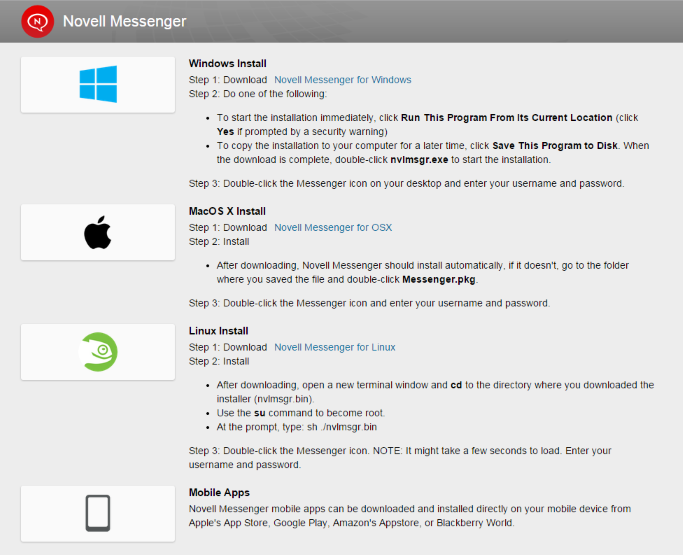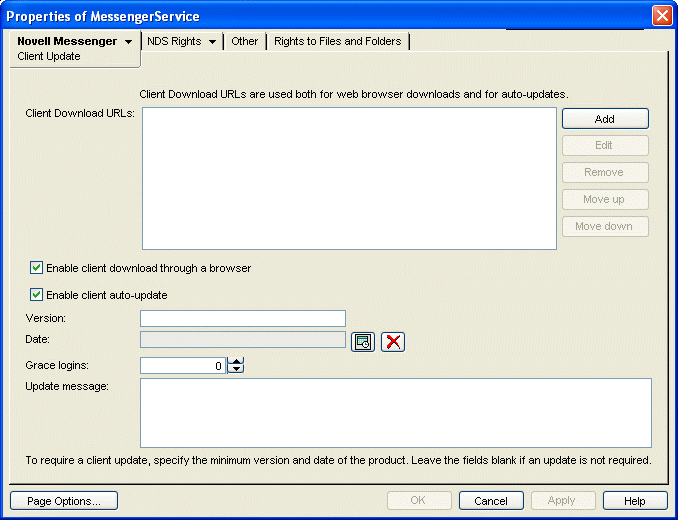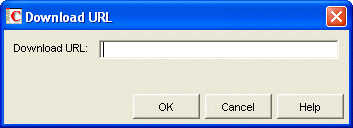3.5 Distributing the Messenger Client Software
You have many alternatives for helping users install the Messenger client:
3.5.1 Using the Novell Messenger Download Page
The Novell Messenger download page is available to users as soon as you finish running the Messenger Installation program (as described in the Novell Messenger 3.0 Installation Guide) and start the Messaging Agent (as described in Section 2.1, Starting the Messaging Agent).
In order for users to access the Novell Messenger download page in their browsers, you need to tell them the IP address or DNS hostname of the server where the Messaging Agent is running and the port number (8300 by default). For example, if you installed the Messaging Agent on a server with an IP address of 172.16.5.18, the Novell Messenger download page is:
http://172.16.5.18:8300
When users view this URL, they see the following page:
Figure 3-4 Novell Messenger Download Page

When users click the Novell Messenger link, they download the nvlmsgr.exe file from the \novell\nm\ma\software\client\win32 directory. By following the instructions on the download page, users can install and start the Messenger client quickly and easily.
3.5.2 Setting Up Auto-Update
You can require Messenger users to update their Messenger client software whenever a new version of the client is available.
-
In ConsoleOne, browse to and right-click the Messenger Service object, then click Properties.
-
Click Novell Messenger > Client Update.

-
Fill in the following fields to configure the update process:
Client Download URLs: Click Add to specify each URL where the user's browser or the Messenger client are redirected when attempting to download the updated client software.
The URLs in the list you create are tried in the order you list them. Ensure that the Messenger nvlmsgr.exe file is available for download from each URL in the list. For more information, see Configuring Your Web Server to Download the Messenger Client.
Enable Client Download Through a Browser: Select this option so that users can download the updated Messenger client software from the Novell Messenger download page, as described in Using the Novell Messenger Download Page.
Update Message: If desired, type the message that you want Messenger users to see when they are notified about the Messenger client update.
-
If you want to require Messenger users to update, fill in the following fields:
Version: Specify the minimum acceptable version number for the Messenger client software.
Date: Click the Calendar button to specify the earliest acceptable date for the Messenger client software.
If you fill in the Version and/or Date fields, users cannot run the Messenger client until they update their software, unless you allow grace logins.
Grace Logins: Specify the number of times users can log in to the Messenger system without updating their Messenger client software.
If you leave the Date and Version fields blank, users can choose whether to update their Messenger client software when they are notified that a new version is available.
Client version information is stored on each user's workstation in the nmcl32.ver file.
-
Click OK to establish the update process.
When Messenger users start the Messenger client, they are notified whenever updated client software is available.
3.5.3 Configuring Your Web Server to Download the Messenger Client
By default, the Messaging Agent handles downloading Messenger client software to Messenger users. If this activity seems to interfere with its ability to handle its instant messaging functions in a timely manner, you can configure your web server to download the client software instead. Before performing the following steps, you should already have created your Messenger system and have the Messenger agents running. You can download either Messenger client (Windows or Cross-Platform) from a Messenger system on any platform (Linux or Windows).
-
In ConsoleOne, browse to and right-click the Messenger Service object, then click Properties.
-
Click Novell Messenger > Client Update.
-
Click Novell Messenger > Client Update.

-
Next to the Client Download URLs list, click Add.

-
Specify the URL of your web server. For example:
http://nm.novell.com:80
Be sure to include both the http:// and the port number where your web server listens for service requests.
-
Click OK to close the Download URL dialog box, then click OK again to save the updated information on the Client Update page.
-
From the Messenger software subdirectory, copy the index.htm file and the msgricon.gif file to the primary document directory of your web server.
On Windows, the Messenger software directory is \novell\nm\ma\software.
On Linux, it is /opt/novell/messenger/software.
If you want to provide the Novell Messenger download page in a language other than English, copy the index.htm file from the appropriate language subdirectory beneath the Messenger software directory.
-
Edit the index.htm file to remove all instances of ~down. For example:
Before: /~down/client/win32/nvlmsgr.exe /~down/client/linux/nvlmsgr.bin /~down/client/mac/nvlmsgr.sit
After: /client/win32/nvlmsgr.exe /client/xplat/linux/nvlmsgr.bin /client/xplat/mac/nvlmsgr.sit
-
Depending on the requirements of your web server, save the file as either index.htm or index.html.
-
Under the primary document directory of your web server, create a client subdirectory, then create a platform-specific subdirectory in it, to create the following directory structure:
primary_doc_dir/client/win32 primary_doc_dir/client/xplat/linux primary_doc_dir/client/xplat/mac
-
From the platform-specific subdirectory (win32, linux, or mac) of the Messenger software directory, copy the appropriate Messenger file (nvlmsgr.exe, nvlmsgr.bin, or nvlmsgr.sit) into the corresponding primary_doc_dir platform-specific subdirectory.
-
In the platform-specific primary_doc_dir subdirectory, create an ASCII text file named files.txt with one of the following lines depending on your client platform:
client/win32/nvlmsgr.exe client/xplat/linux/nvlmsgr.bin client/xplat/mac/nvlmsgr.sit
-
After typing the appropriate platform-specific line shown in Step 12, press Enter so that there is an empty line at the end of the file.
-
Save the updated files.txt file.
-
Repeat Step 12 through Step 14 for each platform-specific subdirectory you created in Step 10, so that you have three files.txt files, one for each platform.
-
Restart the Messenger agents to put the list of client download URLs into effect.
You do not need to restart the web server in order for Messenger users to be able to download the Messenger client software.
3.5.4 Using ZENworks Configuration Management to Distribute the Messenger Windows Client
You can use the Configuration Management functionality in Novell ZENworks 11 to distribute the Novell Messenger Windows client to workstations.
IMPORTANT:This information assumes that you are familiar with ZENworks 11 Configuration Management. It also assumes that you already have all the workstations where you want to install the Messenger client software defined as devices in ZENworks Configuration Management. For background information, or for help completing the ZENworks tasks outlined in the steps below, see the ZENworks Configuration Management documentation at the Novell ZENworks documentation site.
-
Create a bundle for the Messenger software, as described in
Creating Bundles
in the ZENworks 11 Software Distribution Reference. -
Associate the Messenger bundle with devices on your network, as described in
Assigning Existing Bundles to Devices
inManaging Bundle Assignments
in the ZENworks 11 Software Distribution Reference.
3.5.5 Using Red Carpet on Linux to Distribute the Cross-Platform Messenger Client Software
You can distribute the Messenger by using Red Carpet on Linux. For additional information, see the Red Carpet website.